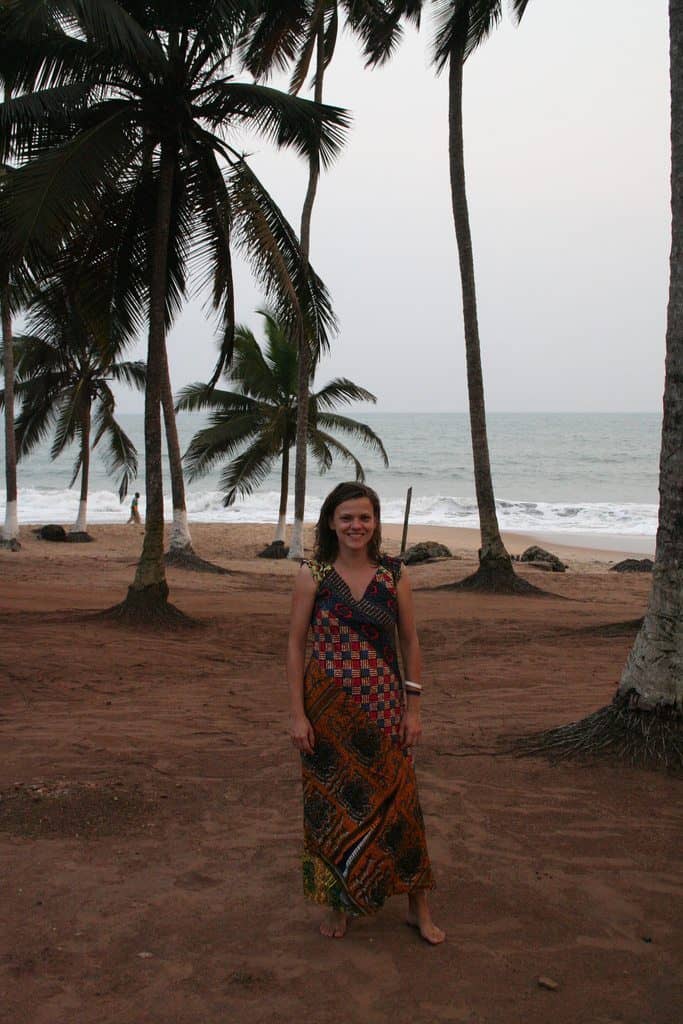The amazing Ghana dress
We were fast approaching Christmas when we arrived in Kokrobite, Ghana.
Packing I had been certain there couldn’t possibly be a reason why I would need a dress in Africa. After all this was a dusty, muddy, sweaty expedition. T-shirts and zip-off pants would do perfectly fine.
But Christmas was around the corner and my girly genes were yelling for prettiness.
One day I went to the village – shaggy houses and a few souvenir shops. The souvenir shops were selling dresses made from asasabu, the patchwork so popular around here. But the dresses were beach wear for the American and European volunteers who supplied the brunt of Kokrobite’s foreign visitors: short and with stretch tops.
I really didn’t want to walk around Africa yelling: ‘I’m a white girl looking for some exotic adventure.’ Locals hitting on foreigners was one of the more annoying features of Kokrobite.
Then a little shed caught my eye: the door was open and I could see posters with dresses on the wall. I went in for a closer look.
The seamstresses were clearly surprised to see me. ‘Can we help you?’ I told them I was looking for a dress but didn’t like the short ones they were selling down the road. In a quiet voice a young woman proposed: ‘I could make you one.’
I don’t even like online shopping because I need to try things on to decide that I like them. So how on Earth could her making a dress for me without a cut to go by work? ‘What if I don’t like it?’ ‘Then you don’t buy it. You only pay when you come back.’
I was intrigued. There was this young entrepreneur in a developing country ready to invest her resources trusting her product so much that she didn’t expect any securities up front. I agreed, gave some details on what kind of dress I was looking for, and had them take my measurements.
Two days later I returned. Mary was beaming when she handed me the dress. It was asasabu style, in warm colors, sleeveless and with a v-neck. It was somewhat modest but still form-fitting.
When I tried it on I was shocked: It fit perfectly! I was a bit embarrassed in view of the now too low price we had agreed on before: 20 Cedi – less than $15. But Mary wouldn’t accept more than that.
Not only did I wear the dress for Christmas and other informal gatherings but also bedazzled officials at the Angolan consulate in Dolisie with it so they ended up giving us a visa (either that or it was my lucky Sunday child charms…).
My advice
A friend of mine likes to preach the three item rule to anyone who will listen. The rule states that travelling you should carry no more than three items of any kind of clothes – three t-shirts, three slips, three pairs of socks,…
Looking at the reality of his bags shows how hard it is to follow that rule when you’re still at home, packing stuff from a full closet. My friend has around four bags (depending on how well he packs that day) with more than a dozen of each of the items mentioned above. Rocking a roller case rather than a backpack makes overpacking even more likely.
The reality of travel (his, too) is that you can only wear one shirt and slip and pair of socks at a time. You can easily survive on very few items. For weeks at a time I have been wearing only one t-shirt, slip and pair of trousers. In a warm climate you simply wash when you get the opportunity (sink, shower, river,…) and put the clothes straight back on. I call that air con deluxe…
Yes, the clothes will eventually break down. But they sell shirts, slips, trousers, skirts and what have you not all over the world. Even in the poorest countries. There are only a few exceptions to that – you won’t find specialty items like zip-offs for women or functional wear in most places.
Saving space on the things you can replace when you have to gives you space to pack little luxury items you sometimes just want.
Like my Ghana dress. Or the best thing made from fabric I bought on the road…
Read more about the best thing made from fabric and my clothing packing list in the next post.

